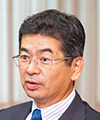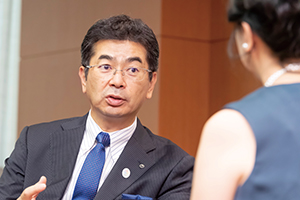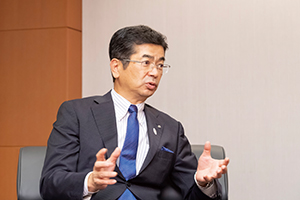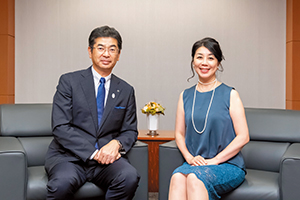 |
|
|
|
|
|
View from the Top Vol. 16, No. 12, pp. 1–5, Dec. 2018. https://doi.org/10.53829/ntr201812tp1  Invigorating Regional Economies and Solving Social Problems with “Local Revitalization Clouds”¡½Building the Present with a View to the Future through “Moonshot” ThinkingOverviewAiming to be a company that contributes to solving social problems, NTT WEST is transforming itself into a pioneer in the era of Internet of Things and artificial intelligence by leveraging the technologies, know-how, and services it has cultivated to date. We asked Mitsuyoshi Kobayashi, NTT WEST President and Chief Executive Officer, to tell us about his plans and specific initiatives in support of the new NTT WEST Medium-term Management Plan that is aimed at creating new value to realize a prosperous, vibrant, and safe and secure society. Keywords: regional revitalization, ICT, cloud Daring to create a synergistic effect among 800 local governments and 2 million companies—Mr. Kobayashi, please tell us about the current business environment surrounding NTT WEST. July 2019 will mark the 20-year anniversary of the founding of NTT WEST. At the time of founding, operating conditions were such that we were operating at a loss of about 200 billion yen. However, in fiscal year (FY) 2016, operating profits reached 95.1 billion yen, a record high in the history of NTT WEST, and after making incremental improvements such as further rationalization of operations, they climbed to 167.4 billion yen in FY2017, making two consecutive years of record profits. I attribute these positive results to nothing other than the tireless efforts of our employees. On the other hand, if we look only at revenues, we can see a 20-year drop, and this is continuing for various reasons, for example, the severely competitive environment and a growing shift toward mobile communications. Specifically, operating revenues were 2700 billion yen 20 years ago but not much more than 1400 billion yen in recent years, an overall drop of about one-half. No matter how much our operating profits rise, a company whose revenues continue to drop can produce some anxiety about the future in its employees. My mission is to resolve this situation, which I think is the earnest desire of all NTT WEST employees. I would like to get on a sound path toward revenue growth as soon as possible. —What kind of strategies do you have in mind? To begin with, what kind of image has NTT WEST as a company been projecting to society? It would probably be a network company or circuit provider that provides fixed-telephone (landline) and optical-broadband services. From here on, however, I would like to be known as an ICT/IoT (information and communication technology/Internet of Things) company that provides its customers with a wide array of services that add value to our existing infrastructure. However, there are already many enterprises working on ICT and IoT and providing services, so we must think carefully about what kind of vision we should have toward the future. To give an example, Japan has been called a developed country facing many challenges such as the declining birth rate and aging society as well as regional disparities. We would like to be a company that can solve such social problems or provide support by using ICT. NTT WEST, in particular, is in charge of the telecommunication networks of a total of 30 prefectures spanning the Kinki, Chugoku, Shikoku, Kyushu, Tokai, and Hokuriku regions, excluding Niigata. The markets that we cover have many remote islands and are dispersed over a large area. In short, there are many small markets under our umbrella, some of which are a microcosm of Japanese society. Problems that are left unattended can provoke crises, so I would like to be a company that sees such situations as opportunities for rolling out new services that will endear us to the people of those regions. The NTT WEST coverage area includes about 800 local governments of diverse sizes and about 2 million companies, most of which are small or medium in size. Each of these entities provides services to the public or to other customers while facing a variety of problems. I would like to take on these local governments and companies as our customers and help them solve their problems or expand their businesses. In this way, I want to meet the expectations of their end users. This is none other than the B2B2X (business-to-business-to-X) model that we have been promoting. With this model, we would like to contribute to the wellbeing of regional communities. To this end, it is important, first and foremost, that we keep in mind our own strengths and features. Fortunately for us, we have communication channels with our customers from past business activities and trusting relationships that we have been building through the years. With these as a foundation to work from, and using technologies not only for communication but also for artificial intelligence (AI) and IoT plus our physical assets (about 4000 central offices and related equipment, about 40 datacenters, 26 call centers, etc.), I would like to promote business process outsourcing services, where companies outsource their work to us, to provide added value to our customers. For example, many local governments have expressed a desire to convert their systems to cloud-based operations, but they are also somewhat anxious about placing their systems and data outside their regions. I think we can eliminate this anxiety by providing comprehensive cloud services that enable local governments to entrust us with their systems at our 40 or so datacenters and to even outsource some of their operations. In addition, there are many small- and medium-sized companies within the NTT WEST coverage area where regional characteristics make for unique types of businesses. Collaborating with such companies provides another opportunity for contributing to these regional communities. It should also be possible to collect large amounts of data by establishing links between local governments and companies and to extract problems and needs by analyzing those data. We can then match up companies and other enterprises with those problems and needs to work out solutions. I have named this process of regional revitalization through community-based collaboration “local revitalization clouds.”
Supporting communities through local revitalization clouds and promoting regional features with tourist-oriented services—That’s a unique and easy-to-understand name. How will you apply local revitalization clouds to the NTT WEST Medium-term Management Plan? I believe that these local revitalization clouds will provide a means of combining people, technologies, and assets to solve social problems and invigorate regions and that we can be of assistance in achieving mutually beneficial collaboration and development. By forming new partnerships and widening our circle with each and every achievement, I would eventually like to create a synergistic effect among 800 local governments and 2 million companies. Under the new Medium-term Management Plan, we plan to substantiate this initiative to build a foundation for achieving revenue growth and stable profits. One specific tactic here is edge computing. In this regard, I would like to make the primary processing and analysis of video and other types of data and their application to diverse measures as the centerpiece of the local revitalization clouds. This approach could be used to tackle the energy problem, which is one key social issue. For example, lead storage batteries are usually installed in our central offices and datacenters as insurance against power outages caused by disasters or other events, and they are of the type that deteriorates through repeated charging and discharging. Since such backup batteries are not used very often, and periodic inspection and replacement are conducted, battery deterioration would not be a major problem. However, such repeated charging and discharging makes lead storage batteries unsuitable for everyday use. However, if lithium-ion batteries could be used instead, no such deterioration would occur, which means that they could be used on a day-to-day basis. If this were to happen, I would like to explore the use of central offices and datacenters as core energy-supply facilities by utilizing AI or ICT to monitor battery conditions and perform optimal power transmission and distribution. At the present stage, cost and safety problems are a concern, so we are studying solutions to these issues together with the NTT laboratories. In a way, this is related to the local production and consumption of energy. A central office typically covers customers dispersed over an area with a radius of about 8–10 km, and it would be located in the city center from the viewpoint of efficiency. The electric power generated by solar panels located in this area could be used to charge the lithium-ion batteries in the central office, and customers in the same area could then be supplied with power. Although a variety of means already exist for transmitting energy from a power plant to remote locations, they result in much power loss that could be reduced by local production and local consumption. I would like to achieve continuous growth as a company that creates a virtuous cycle and endears us to a region through such community-based services and businesses that invigorate local economies. —2020 is near at hand. How does NTT WEST plan to deal with this historic year? The international sports event of 2020 will be held in and around Tokyo, but this does not mean that all inbound visitors to the events will remain in the Tokyo area. At present, visitors to Japan using Kansai International Airport make up about 30% of all visitors. Together with visitors to Japan who use Chubu Centrair International Airport in Nagoya, Fukuoka Airport, and other airports in western Japan, we can say that about 50% of all visitors to Japan get off an airplane somewhere in this area. To provide these guests with even better services, we are currently deploying augmented reality systems at airports to provide information services that can be accessed by simply holding up a smartphone, and we are providing digital signage to attract customers. I believe that going forward, we can use ICT to make more contributions like these in an indirect way. We are also preparing services for all major international events to be held before and after 2020 including the Rugby World Cup and G20 Summit in 2019. These services will naturally include navigation services in the manner of airport information services, but our main mission here is to support communications. In addition, other events that are expected to draw large numbers of guests are being planned or envisioned based on the concepts of integrated resorts and MICE (meetings, incentives, conventions/conferences, and exhibitions). Our main role here will be to provide support through ICT and AI technologies including cybersecurity measures. I feel that taking advantage of these opportunities to support inbound visitors may also be effective in revitalizing Japan on the whole. Also, responding to and supporting people with diverse customs and values can give us a new perspective on the world. It could lead to activities for solving social problems such as the declining birth rate/aging society and regional disparities. I think that such initiatives and activities are somehow helping western Japan to come alive compared with conditions a few years ago. As I alluded to earlier, it could be said that the 800 local governments and 2 million large and small companies in western Japan are collaborating with each other, and that this diversity in values and viewpoints is helping to support the economy of western Japan.
Let’s create excitement, inspiration, and brilliance through “moonshot” thinking—In such an environment, how do you carry out your beliefs as a top executive? NTT WEST employees may be tired of hearing it, but I often use the word “moonshot.” This word is used by engineers in the United States and goes back to the space development policy and Apollo program put forth by President John F. Kennedy upon taking office in 1961. The Cold War between the United States and Russia (formerly called the Soviet Union) was an era of fierce competition in space development as a matter of honor. At that time, Russia was ahead, but President Kennedy declared, “This nation should commit itself to achieving the goal, before this decade is out, of landing a man on the moon and returning him safely to Earth.” These words were not simply a call to compete through a steady improvement of technology. Rather, they expressed the importance of setting a goal and looking at what should be done to achieve the original objective of sending human beings into space. The Apollo 11 lunar module touched down on the lunar surface in 1969 and fulfilled the mission of landing people on the moon and returning them to Earth. This word “moonshot” originates from this historic mission. It expresses the idea of setting a primary objective or establishing the goal of understanding the true essence of something and thinking how to approach the problem. We tend to make an effort to solve problems that are close at hand, but it is more important to consider primary objectives and issues. By the way, there are three principles behind a good moonshot. First, is it original? Second, does it have a certain technical foundation and can its success be envisioned? And third, does its proposal and plan fascinate many people and create a desire for cooperation? I can proudly say that the new NTT WEST Medium-term Management Plan is a “moonshot.” —Do you have a message for researchers? I would like to see more research related to regional revitalization, and I would like to work together with researchers to return the results of that research to our customers. Some products such as WinActor, ForeSight Voice Mining, and @InfoCanal have already been introduced, and I expect more to follow. WinActor is a robotics process automation tool that improves business efficiency by using a bot to automate repetitious input tasks, thereby shortening work time and reducing input errors. Many customers in western Japan are using it, and it’s a product that I heartily recommend to other customers. ForeSight Voice Mining, meanwhile, is a voice-oriented big data solution. It can be used, for example, at call centers to automatically extract customer complaints from phone calls. It is not limited to extracting emotional complaints in which a voice is raised in anger, for example. It can also infer and extract emotionally contained, matter-of-fact complaints based on intonation or pauses, which have been difficult for existing systems to automatically extract. This solution can improve business operations and enable the provision of services that better fit customer needs. Finally, @InfoCanal is an information delivery service targeting a wide range of terminals that use an IP (Internet protocol) communications network including the cloud and mobile phone network. It has already proven to be extremely useful in recent disasters as a means for local governments to deliver disaster information. To give some background, broadcasts made over a community wireless system may be drowned out by the sound of heavy wind, and it may not be possible to confirm whether that information has actually reached the residents. The @InfoCanal product makes it possible to deliver disaster information all at once by text and voice to smartphones and tablets, dedicated home receivers for the elderly, and disaster-prevention radio terminals. It also has bidirectional capabilities that can be used for safety confirmation purposes and for sending individual messages to non-responding terminals for double-checking. This feature enables a local government to visualize the ratio of residents who have received the information. These products all use technologies developed by the NTT laboratories. NTT Advanced Technology and NTT TechnoCross transformed these technologies into practical and commercial products, and we have the role of delivering these products to our customers. There are many examples of such relationships within the NTT Group, too many to mention. I would like to expand and strengthen these relationships. In addition, I would like to ask researchers to work together with us in making regional contributions by fostering new technologies in edge computing and energy too. When our engineers make contact with customers, the customers are relieved to hear comments such as, “We have research laboratories within the Group and many technologies like this one.” This results in a favorable response from our customers, which underscores just how important a role the NTT laboratories play. This is why we are committed to delivering the output from the laboratories to our customers. —Mr. Kobayashi, can you leave us with a message for all NTT WEST employees? I would be happy to. In the end, you cannot excel in your work if you don’t enjoy it. I believe that having one’s existence as a company or individual recognized as being useful to society is what makes work pleasurable. There is truly nothing more enjoyable than having yourself or your company and the value of your work appreciated as expressed by the words “Glad you’re here!” or “Glad you could do this for me!” To this end, you must take pleasure in your work. I believe that having joyful and exciting times is very important. The role of managers is to create an exciting company and implement stimulating work procedures, and we are working hard to create such an environment, so I would like to ask everyone to be excited about your work even when times are difficult. If you are excited, you will be inspired, and then you will be brilliant! If you do your work with a sense of joy, good ideas will come to you. And if good ideas come your way, you can excel in your work and shine, which then fosters a virtuous cycle of having the world around you appreciate the work that you do.
Interviewee profileCareer highlightsMitsuyoshi Kobayashi joined Nippon Telegraph and Telephone Public Corporation (now NTT) in 1982. He served as General Manager of the Okayama Branch of NTT WEST beginning in 2006, General Manager of the Service Management Department of NTT WEST beginning in 2008, Senior Vice President and General Manager of the Service Management Department of NTT WEST beginning in 2010, Senior Vice President and Director of the Technology Planning Department of NTT beginning in 2012, and Executive Vice President and Director of the Technology Planning Department of NTT beginning in 2014. He took up his present position in June 2018. |



